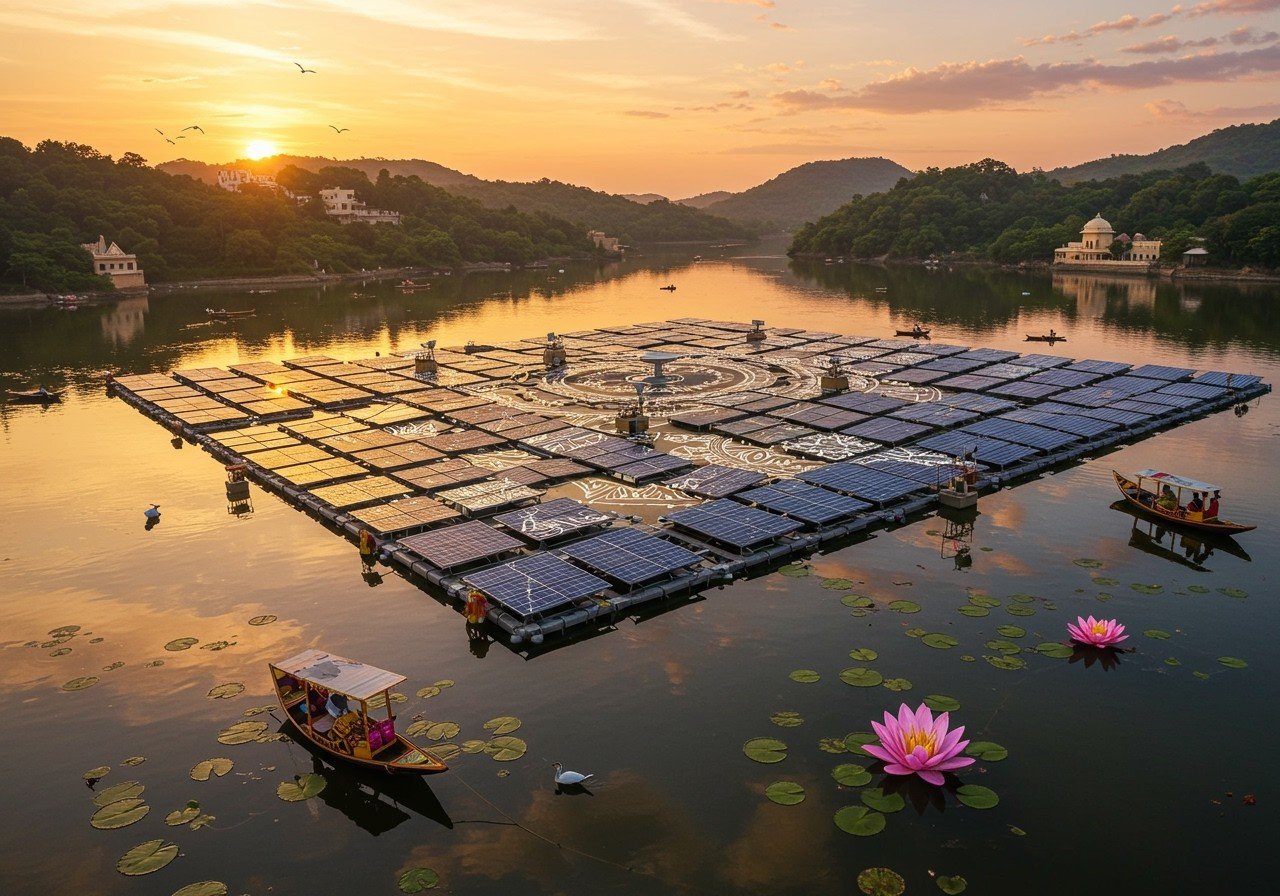
Floating solar power plants offer a compelling solution to India’s increasing energy demands. These innovative systems exemplify a harmonious blend of cultural values and environmental consciousness, providing sustainable electricity generation without consuming precious land resources. As the need for renewable energy intensifies, floating solar technology emerges as a promising avenue to fulfill this demand while supporting traditional practices and modern lifestyles. This pioneering approach plays a crucial role in India’s transition towards sustainable development and contributes significantly to the global fight against climate change.
Understanding Floating Solar Power Plants
Floating solar power plants, also known as floatovoltaics, are photovoltaic systems installed on bodies of water like lakes and reservoirs. These plants operate by utilizing solar panels to capture sunlight and convert it into electricity. Floating systems possess several advantages over land-based counterparts:
- Reduced Land Use: Eliminates the need to acquire valuable land, a significant advantage in densely populated areas. This preservation of land allows for other essential uses, such as agriculture or urban development. Furthermore, it minimizes disruption to existing ecosystems.
- Lower Water Evaporation: The panels provide shade, mitigating water evaporation rates. This conservation is particularly important in regions facing water scarcity. Moreover, reduced evaporation helps maintain water quality by minimizing the concentration of pollutants.
- Improved Efficiency: Cooler water temperatures beneath the panels enhance their operational efficiency. This cooling effect leads to higher energy output compared to land-based systems, making floating solar farms more productive. This increased efficiency translates to greater energy generation for the same panel area.
Advancements in technology, including robust anchoring methods and durable solar panel materials, have made these plants increasingly viable. This technology is reshaping the landscape of renewable energy generation, providing practical solutions with minimal environmental impact. Those interested in traditional offerings for solar-related rituals might find relevant items on poojn.in.
Floating Solar Power in India
India is actively embracing floating solar technology to achieve its renewable energy targets. With abundant water resources and plentiful sunlight, the nation is ideally positioned for these projects. Governmental initiatives, including subsidies and tax incentives, bolster this transition. These efforts form an integral part of India’s strategic shift towards sustainable energy.
Geographical and climatic factors contribute to making India a prime location for floating solar projects. The numerous reservoirs and lakes provide ample space for installation. Additionally, India’s sunny climate ensures efficient energy generation. For auspicious beginnings, explore our collection of camphor and other ritual items at poojn.in.
Successful case studies highlight the positive effects of floating solar projects on local communities and the surrounding environment. For instance, a project in India resulted in the conservation of approximately 9 million liters of water annually. This not only preserves valuable water resources but also benefits local ecosystems by reducing algae growth.
Largest Floating Solar Power Projects in India
India is home to several impressive floating solar power projects. One notable example is the project at Ramagundam, Telangana, which is currently the largest in India. These projects, while facing challenges such as logistical complexities and environmental considerations, yield positive outcomes including enhanced energy security and reduced carbon footprints. Local communities also reap economic benefits from these initiatives.
Challenges of Floating Solar Power Plants
Implementing floating solar farms comes with its set of challenges. Environmental considerations include potential impacts on aquatic life. Thorough site selection, environmental impact assessments, and ongoing monitoring are vital to minimize any negative effects. Additionally, the durability of materials in aquatic environments presents a technical challenge. Anchoring systems must withstand water currents and weather conditions, necessitating specialized maintenance. Social and economic aspects, such as initial installation costs and integration with existing power grids, also require careful consideration. Engaging local communities and stakeholders is crucial for successful implementation.
Benefits of Floating Solar Power Plants
Floating solar power plants offer a multitude of benefits. Environmentally, they contribute to reducing greenhouse gas emissions and conserve valuable land resources. Water conservation is another key advantage, with some projects reducing evaporation by as much as 70%. Economically, these plants generate employment opportunities and enhance energy security. They also promote technological innovation, creating new avenues for growth. Socially, floating solar farms improve access to clean energy, particularly for rural communities. They align with traditional practices of environmental stewardship, demonstrating respect for cultural values while offering the benefits of modern technology. Celebrate the sun’s energy with authentic pooja items from poojn.in.
How Floating Solar Farms Work
Floating solar farms utilize the same fundamental technology as traditional ground-mounted solar farms: solar panels and inverters. These components work together to convert sunlight into usable electricity. The key difference lies in the mounting system. Instead of being fixed to the ground, the solar panels are mounted on floating structures. These structures are typically made of pontoons or high-density polyethylene (HDPE) plastic floats, chosen for their buoyancy and durability in aquatic environments. Underwater cables then transmit the generated electricity from the floating platform to the onshore grid, where it can be distributed for consumption.
Poojn.in: Supporting Your Solar Energy Journey with Traditional Offerings
At Poojn.in, we recognize the spiritual significance of the Sun (Surya) in Indian culture. We offer a wide range of products suitable for ceremonies related to solar energy projects. For those embarking on floating solar power ventures, we provide:
- Surya Yantra: A sacred geometric diagram symbolizing solar energy, ideal for installation at project locations to invite positive energy.
- Pure Copper Vessels: Traditional items for water offerings during solar-related rituals, adding a touch of authenticity to your ceremonies.
- Organic Ritual Items: Including pure ghee, kumkum, and rice, essential components for project inauguration and other ceremonies.
- Vastu Consultation Items: Sacred items recommended by Vastu experts to enhance energy flow and harmony within solar installations.
- Cotton Thread (Moli): For tying around wrists during prayers or offerings related to solar energy projects. Available in various colours on poojn.in.
Discover a wide selection of clay pots, ceremonial trays (baran dala), and more on poojn.in, perfect for traditional offerings at floating solar power plants.
Our products are carefully curated to preserve authenticity while catering to the needs of modern projects. We deliver across India, ensuring convenient access for project managers and stakeholders to traditional items for ceremonies at floating solar power plants. For bulk orders related to large-scale solar projects, we offer specialized packaging and corporate discounts. Our knowledgeable team can assist you in selecting appropriate items based on regional customs and specific ceremony requirements. Visit www.poojn.in or contact our customer service for assistance with your solar project’s ceremonial needs. All products are quality assured and packaged with care to maintain their sanctity during transit.
Conclusion
Floating solar power plants represent a promising avenue for India’s energy future. These projects elegantly combine innovation with tradition, harnessing the power of the sun while respecting the delicate balance of land and water resources. As India increasingly adopts this technology, it paves the way for a more sustainable and secure energy landscape. Government support and community engagement are vital to overcoming challenges and realizing the full potential of floating solar power. With continued dedication, these projects can illuminate homes, empower communities, and safeguard the environment for generations to come. Read more about Sun Temple Modhera and Martand Sun Temple on poojn.in.


